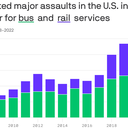Violent crime against transit workers tripled since 2008

Violent assaults on transit workers have tripled since 2008 — with a major surge happening post-pandemic, according to the Urban Institute.
Why it matters: As officials seek to coax people back to public transit and cities, rising violence and incivility in public spaces are a big deterrent.
- Health care workers and government officials have also been targets of rising harassment and threats.
Driving the news: "Major" assaults on transit workers — those resulting in death or requiring medical transport — rose nearly threefold nationally between 2008 and 2022, from 168 to 492, the Urban Institute found, using data from the Federal Transit Administration's National Transit Database.
- The numbers would have been exponentially higher had they counted less grievous assaults, including hitting, kicking and spitting.
- "Operators have also reported being robbed, having things thrown at them, being doused with urine and hot beverages, being threatened at gunpoint, and shot at," the Urban Institute noted in its blog post on the topic. (These incidents wouldn't rise to the level of "major.")
- NJ Transit, for example, only reported three "major" assaults in 2021. But "reports from other sources have cited the agency with more than 130 assault events for the same year," the Urban Institute said.
Yes, but: NJ Transit says it "actively implemented several protocols that successfully drove a downward trend in assaults on its employees over the past year," Kyalo Mulumba, a spokesman for the agency, tells Axios.
- There were only 13 assaults on NJ Transit rail employees between June and December of 2023, down from 21 in the same period of 2022.
- Assaults on bus employees were also down, to 44 from 62 during the same period.
- The agency credits increased train patrols, its "Ride Kind" messaging campaign, and employee training in de-escalation for the improvements.
Of note: This year's National Transit Database figures will include all assaults — even minor ones — thanks to the 2021 infrastructure law, which stepped up data collection and reporting requirements for all transit agencies.
- The Federal Transit Administration has also announced a $500,000 grant to examine safety risks to transit workers and riders — and possible solutions.
Where it stands: Not only has the number of assaults been rising, but the assaults are happening in more places geographically.
- They're also affecting more types of workers in more locations, including "transit ambassadors" stationed in subway and bus stations, and drivers on their lunch or restroom breaks.
- Bus and rail operators "commonly cite the use of racial slurs and a refusal to pay the fare when describing attacks," the Urban Institute said.
- "It is everywhere, and it is growing," Lindiwe Rennert of the Urban Institute, who conducted the study, tells Axios. "The numbers are skyrocketing."
By the numbers: While Albuquerque and Chicago had the highest assault-count-per-rider ratios in 2022, New York City had the most frequent assaults.
- New York's Metropolitan Transportation Agency went "from one occurrence every 3 days in 2008 to once every 1.4 days in 2022," per the Urban Institute.
- The problem has affected recruitment: A survey by the American Public Transportation Association found that more than nine in 10 public transit agencies were having difficulty hiring new employees, particularly bus drivers.
Context: While high transit fares may be an immediate catalyst for some attacks, Rennert sees a direct link between rising income inequality and societal tensions and the escalation of major assaults, particularly post-pandemic.
- "My theory here is that this sense of feeling forgotten or intentionally left out or deprived of a system we need — transit — is weighing on us to the point where aggression works in," Rennert said.
- "I think it's this sense of dearth or loss, or of being deprived of something — this sense of feeling, 'I am powerless, I am furious, and I don't trust the institutions that are supposed to care for me.'"
When an assailant confronts a transit worker, it's a moment of feeling, "I have power over a moment, or I have direct access to a representative from these institutions," Rennert said.
- "The more unequal our society feels, the more assaults we're seeing — there's a relationship there."
What they're saying: "Incivility, hate and extremism" are on the rise, and "no other level sees the impact as acutely as the cities themselves, the local community," Clarence Anthony, CEO and executive director of the National League of Cities, tells Axios.
- Local elected officials are among those on the front lines of the abuse.
- "We surveyed our members, and over 80% said they had experienced some form of harassment," Anthony said, "whether it is in virtual meetings or in front of their homes — protests, attacks in the post office or grocery stores."
- "It's having an impact on public service," he added. "We're seeing more and more local leaders saying, 'I'm not running for reelection.'"
The latest: Union representatives have been seeking stiffer penalties against those who assault transit workers.
- Measures along these lines have passed in New York and elsewhere.
- Bus drivers have also been lobbying for bulletproof glass partitions.
- Some transit systems are no longer requiring drivers to apprehend fare scofflaws.
Yes, but: Systemic changes are necessary to address income inequality and social tensions, Rennert said.
- "While these efforts might make a difference, they are really trying to solve symptoms — they are really not getting to the core of what is driving these assault numbers up and up and up."
What's next: Thanks to the new data collection requirements, next year's portrait of assaults on transit workers will be far more expansive and illustrative.
- "The reporting is really going to step up and improve clarity," Rennert said.